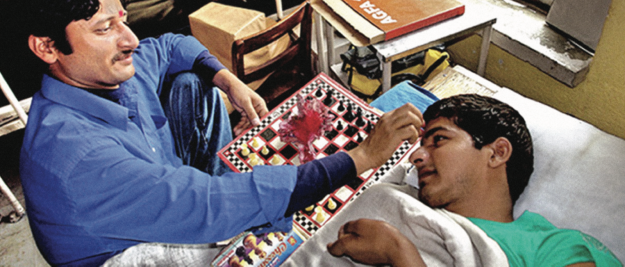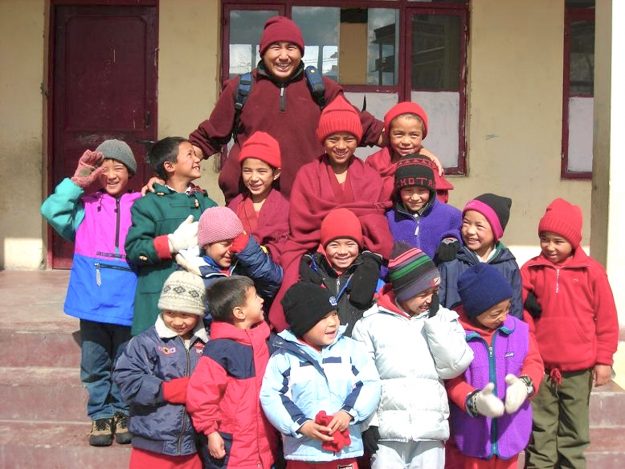In August of 2000, Kanak Mani Dixit, an editor and publisher from Kathmandu, Nepal, set out on a trek around the Annapurna Circuit trail, several hours north of his home. After he failed to return to Kathmandu a few days later, his brother went out in search of Dixit and eventually discovered him stranded on a cliffside below the trail. Dixit had slipped from the path during his trek and suffered damage to his spinal cord in the fall.

Thanks to his family’s efforts and the aid of a Sherpa, who helped lift the injured trekker to safety using a piece of corrugated tin roofing, Dixit was rescued and began a yearlong rehabilitation process. It was during this time that he became aware of the severe lack of facilities available to Nepalis suffering from spinal injuries—many of whom are women and children who fell while collecting tree fodder or herding animals. In response to this need, and with the help of a few friends, Dixit set up the Spinal Injury Sangha Nepal in the winter of 2000. The Sangha’s main objective was “to roll back…the despair that is the burden of the spinally injured and their families.” Two years later, in collaboration with the Nepal Disabled Association, the Sangha inaugurated the Spinal Injury Rehabilitation Centre (SIRC) in Jorpati, Kathmandu. At its opening the famed Everest climber Sir Edmund Hillary spoke.
In 2008, SIRC inaugurated a new facility in Sanga, 20.5 km from Kathmandu. The center has 39 beds for inpatient care, and its staff members include doctors, nurses, physiotherapists, occupational therapists, and a dietician. In addition, the clinic has a social services department that offers wheelchair services and vocational training. SIRC provides financial assistance to the majority of the patients, often heavily discounting or waiving the rehabilitation fees, and the facility takes a holistic approach to rehabilitation with the hope that patients will be more easily integrated into their communities when they return home.
TO HELP: sirc.org.np
Roughly 30 years ago, when Geshe Lobsang Yonten was a child, he embarked on the perilous journey from Zanskar—a remote region of northern India—to greater India to receive an education. In 2003, Geshe-la founded his own charitable initiative, Save Zanskar, to pass on the invaluable gift of education to Zanskar’s youth.
Save Zanskar aims to preserve the distinct culture and secure the future of the people of this impoverished region through educating its youth. Zanskar’s inaccessibility has kept its inhabitants illiterate and without basic utilities such as electricity and water, but it has also served to safeguard their unique, distinctly Tibetan Buddhist culture, society, and buildings through times of political turmoil, including the Chinese Cultural Revolution. It is for this reason that the Dalai Lama has stated that Zanskar is vital to the survival of Tibetan Buddhism.

Eight years ago, Geshe-la brought the first group of children—17 of them, some as young as four years old—from Zanskar to Manali and Dharamsala, India, for schooling. Their parents entrusted them to Geshe-la, knowing the risks of the journey and that they probably would not see their children again for 10 or 15 years. The families were willing to make such sacrifices in order to give their children an education that would otherwise be unthinkable. The journey of this first group of brave kids was chronicled in the film Journey from Zanskar, directed by Frederick Marx (Hoop Dreams) and narrated by Richard Gere. Donations to Save Zanskar will allow Geshe-la to bring more children from Zanskar to schools in India and support their education there. A copy of the film Journey from Zanskar is available at no charge.
TO HELP: savezanskar.org
What would happen if we met challenges in the developing world by combining modern technical know-how with the time-tested knowledge of indigenous communities? Drokpa is a small nonprofit organization dedicated to collaborating with pastoral communities across the Himalayas, the Tibetan Plateau, and Central Asia to find solutions to the most urgent problems that these areas face today. By providing seed grants and infrastructure support for higher Himalayan communities, Drokpa (the word means “nomad” in Tibetan) serves as a bridge linking modern and indigenous systems of knowledge to develop energy resources and promote education, health care, and economic opportunities.
Drokpa’s goal is to address vital social and economic issues while ensuring the survival of nomadic and pastoral community cultures. One especially inspiring example of the organization’s efforts is its Social Entrepreneurs Program, which provides grant money to individuals and local organizations like the Dolpo Artists’ Cooperative, which supports apprentice training under the guidance of traditional Tibetan artists.
TO HELP: drokpa.org
As it becomes readily apparent that stress impairs the effectiveness of our educational system—where achievement is understood in terms of test scores and undermined by technology induced instant gratification—Mindful Schools offers a solution. Founded in 2007, this innovative California-based program has taught over 10,000 students and 450 teachers in 38 schools the basics of mindfulness: how to focus, manage emotions, handle stress, and resolve conflicts through direct intervention and reflection upon experience.
Utilizing the resources of qualified educators who allow students to develop an attitude that is focused and empathetic, the organization transforms the school environment into a refuge of contemplation. Mindful Schools courses are typically delivered in 15-minute lessons offered three times a week during a five-week session. This progressive approach has been proven to effectively address juvenile delinquency, poor academic performance, and adolescent anxieties.
TO HELP: mindfulschools.org